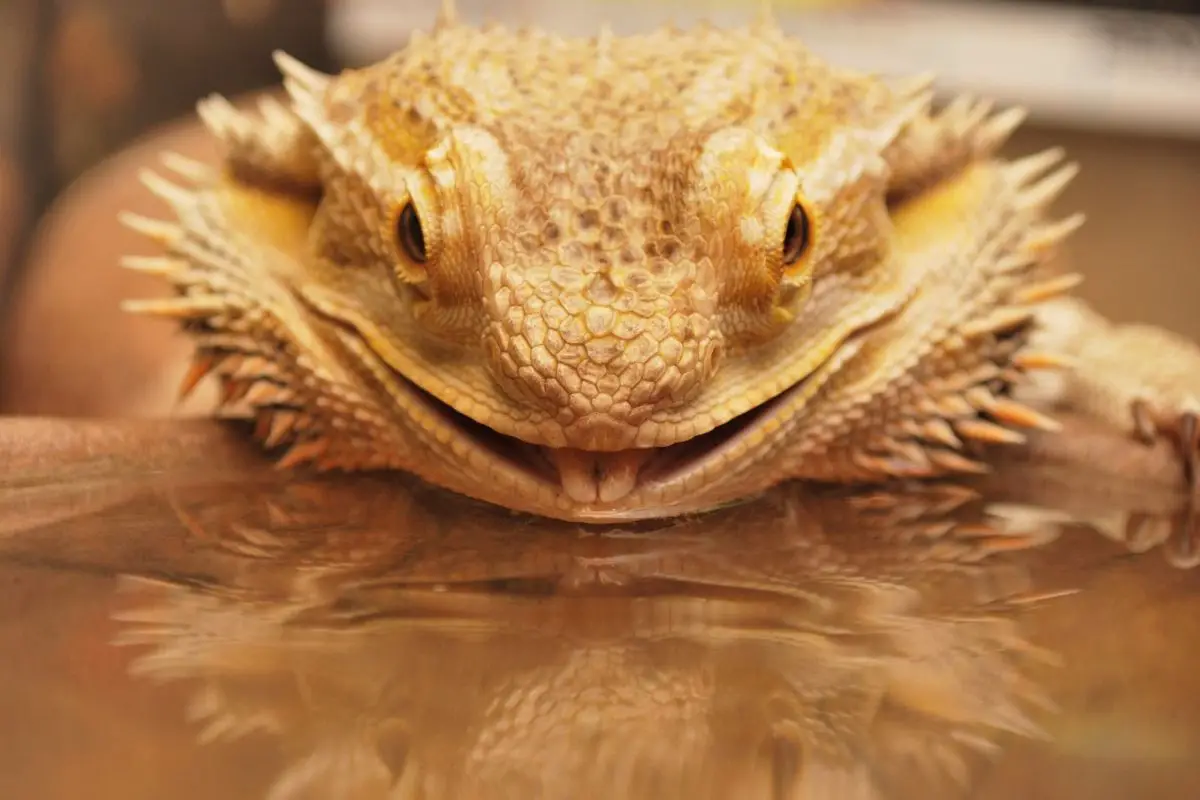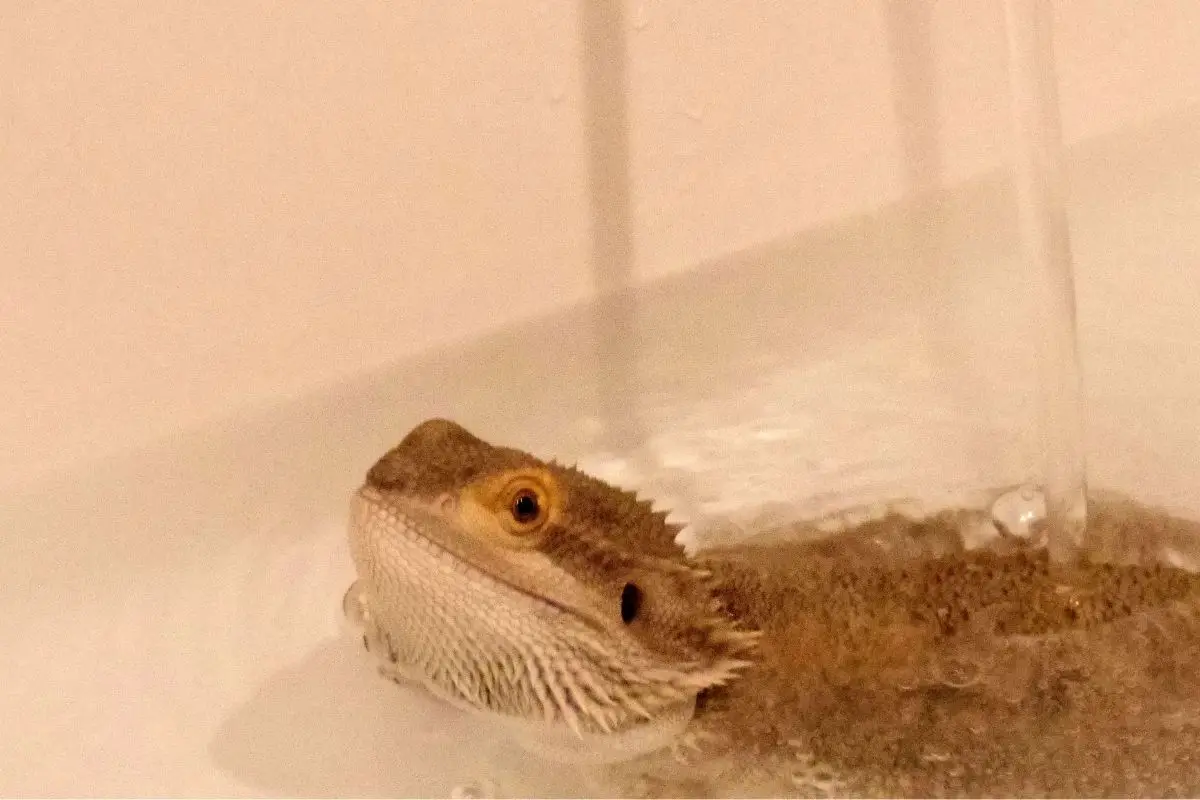Bearded dragons can be quite high-maintenance pets; they’re quite hard to domesticate and have some requirements that can cause extra work than a ‘normal’ pet.
There are also a few illnesses they become susceptible to in captivity.
The bearded dragon is actually one of six within the genus of ‘Pagona’; the term ‘Bearded Dragon’ refers to their neck area or throat. This area turns black and puffs out when the animal feels threatened or stressed.

One other reason they are hard to keep is that this genus of lizards known as ‘Pagona,’ which the beardie is part of, is endemic to Australia.
That is to say that their natural habitat is, in fact, a very dry area; beardies mainly inhabit deserts, shrublands, and woodlands of Eucalyptus trees; these areas can be hard to mimic in the US.
Providing the bearded dragon with water can be hard to judge; there are many factors that go into how much water they need, how they interact with water, and also, when you are giving them too much water, it’s not as simple as feeding your dog, unfortunately.
In the following article, we have covered what you need to know about giving your bearded dragon water.
Why Isn’t My Bearded Dragon Drinking?
This is one of the largest questions asked when feeding bearded dragons and highlights one of the reasons why the Pagona is hard to look after in captivity.
Here is the most important thing to consider when providing a beardie with water, and is often not known by many first-time owners. A bearded dragon cannot see the water that isn’t moving, in the wild, especially in the desert. When they come across the water, it is always moving.
There is no ‘dead’ water in the wild.
To reiterate, if you put water into a bowl as you would for a dog, a bearded dragon will pay no attention to it. They can be trained to drink from the water like this, though.
But watering them, in aggregation with this fact, requires knowledge of many other factors, which we will get into.
So, How Much Water Does A Bearded Dragon Need?
Well, this, again, is very much based on how they operate in the wild and is another fact that many owners may not realize.
In the wild, a bearded dragon will likely only drink during the rainy period of the year. A bearded dragon is naturally endemic to desert regions in Australia, where it basically only rains in one period of the year.
During this rain period, a bearded dragon will drink in excess for the rest of the year.
In fact, during the majority of the year, when it’s very dry and arid in their natural climate, a bearded dragon will actually source most of its water from food.
Most food they eat will have some water content, just like ours does, so they survive mainly on this, occasionally licking morning dew from flower petals, etc.
They evolved to live in this dry climate, so they are made to go without water.
So, to answer the question, there isn’t really any specific answer to how much water they need.
If you think about them in the wild, there is no one to feed them water or food; a bearded dragon will drink water when they know they need to.
Some owners find they have only seen their beardie drink once or twice after having them for years.
Technically, you could potentially make your bearded dragon ill by giving them too much water, as dehydration is a fairly natural state for them in the desert.
However, this is unlikely to happen as a bearded dragon is clever enough to know when to drink or not. Even if you have a gallon of water in front of them, they won’t drink it.

How Can I Get My Beardie To Drink In Captivity?
When your bearded dragon is in captivity, getting them to drink can be hard when they are new. Put a different way, a bearded dragon who is thirsty and actually needs water still may struggle to drink in captivity.
Yet, here are some foolproof ways to get your beardie to drink water and stop them from being dangerously dehydrated.
As we mentioned, a bearded dragon will very rarely ever drink from a bowl like a dog. As we mentioned, though, bearded dragons will lick droplets of water regularly, especially during the morning dew.
You can almost simulate the morning dew with a mister. Before your dragon has awoken, you can spray the mister around the cage creating water droplets that will drip onto their body and make their way into their mouth.
A mister like this is ideal; you don’t need anything huge as they don’t need much misting or regularity in it.
What’s more, the bearded dragon actually loves sliding across mildly wet surfaces, which seems to be a fun activity for them in captivity. They also hydrate their body this way and lick up bits of water as they slide around.
Another way to encourage them to drink on their own when they need it is to use a dropper or dripper. As we mentioned, they can’t see still water, so forget buying any sort of bowl like that.
A dripper essentially drips very slowly over a long period of time. This means that if they need water, they can see the droplets and know they can rehydrate themselves as they need to.
A dripper like this is great; it drips into a bowl which you can just refill the bottle with. If a bearded dragon in captivity wants to drink, this is the most effective way to get it to happen.
How To Tell If A Bearded Dragon Is Dangerously Dehydrated?
With all this said about bearded dragons existing in arid climates, not needing too much water, and all the rest of it, your bearded dragon can still be dangerously dehydrated.
If you use a mister and dripper, then dehydration should be avoidable and only occur when the bearded dragon is ill.
Being dehydrated is a common state for a bearded dragon, but when in captivity, there are circumstances when they are clearly over-dehydrated.
There are some subtle physical tells from a bearded dragon that will indicate it needs water and is dehydrated.
- When they open their mouth, if their saliva is very sticky and comes in strands as they open their mouth, this will signal they need water.
- Wrinkled and overly dry skin can show they are dehydrated; this is where a mister is best used.
- Another sign from their skin is when it stops being stretchy and elastic like normal and becomes more rigid and noticeably dry.
- Sunken eyes have also been proven to be a sign of dehydration in bearded dragons.
- A much more lethargic and comatose-like state that is different than usual can indicate dehydration.
Frequently Asked Questions
Can a Bearded Dragon Drink Tap Water?
Yes, a bearded dragon will drink tap water; you don’t need demineralized water or anything like that.
Hard water is best and most safe for reptiles; soft water can be sodium-rich, but this isn’t a problem unless the animal can’t have sodium for medical reasons.
Can you Bathe a Bearded Dragon?
Yes, there’s no need to worry about this. When they have settled into captivity, regular baths can encourage good sanitation and hygiene with your bearded dragon.
If your enclosure is enough to have a small pool of clean water, you may find they go into this occasionally.
If you are using a human bath, then don’t let the water go above the knee joints, and make sure the water is dechlorinated as well as not too warm either.
Final Thoughts
So, as you can see, feeding a bearded dragon water is a little more intensive than you may have first thought.
In summary, a bearded dragon cannot see water that isn’t moving. So, trying to give them water in a bowl will not suffice. They literally cannot see it and won’t realize there is water within the vessel.
In the wild, a bearded dragon will only drink during the one period that it will rain in their arid but endemic environment.
So a bearded dragon does not need much water at all. However, a bearded dragon can still become dehydrated, the signs of which are listed above.
To feed a bearded dragon water, a mister should be used to simulate morning dew in the desert and create water droplets the bearded dragon can see.
A dripper can also be an effective way to get a bearded dragon to see water and drink the small amount they need.
A bearded dragon is an animal that has not evolved for captivity or domestication in the same way a dog has.
Captivity can be extremely confusing for bearded dragons, and their biology isn’t really suited to captivity either. In any case, this makes looking after a bearded dragon a very special challenge.
Good luck!
